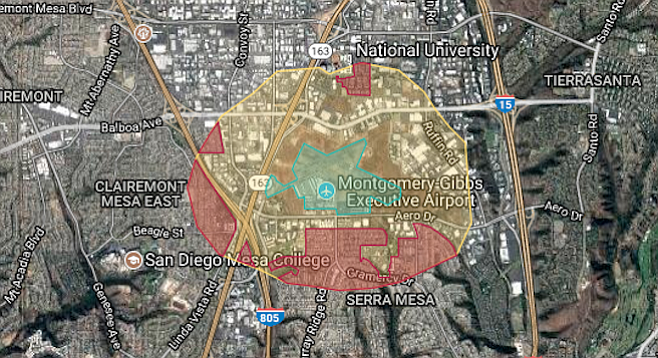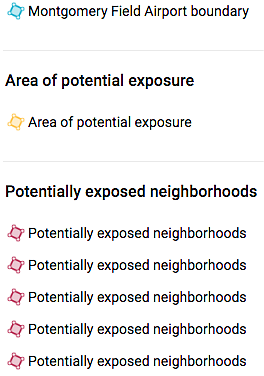 Facebook
Facebook
 X
X
 Instagram
Instagram
 TikTok
TikTok
 Youtube
Youtube

Usually when people complain about small regional airports, the issue is noise. But Serra Mesa resident Gary Keller is worried about lead poisoning, and a California health coalition — supported by EPA research — says his concerns are valid.

"Far more insidious is the fact that the small piston-driven engines that make up most of your fleet continue to burn Avgas,” he said. “Serra Mesa has the most elementary schools, daycare facilities, and most minority children of the areas near the airport, and we should be protecting them.”
Avgas is now recognized as the leading source of lead in air pollution — putting about 500 tons of the toxic heavy metal in the air each year. Lead is part of the fuel formula because it is believed to enhance engine performance. It’s also a major focus for people concerned about environmental health says Caroline Cox, research director with the Center for Environmental Health in Oakland.
In 2014, the center settled a lawsuit over the ongoing use of leaded aviation gas brought against 30 California companies that sell or distribute Avgas at 23 California airports, including Montgomery and Brown Fields.
According to the Centers for Disease Control and Prevention and the National Institutes for Health, lead is a well-documented neurotoxicant that is particularly harmful to children. Serious harm to cognitive and behavioral functions (including intelligence, attention, and motor skills) has been demonstrated in children with much less lead in their blood than previously thought to cause harm, and it has been determined that there is no safe level of lead exposure.
“Every year we identify causal links to more and more health problems that are caused by lead,” Cox said. “Lead is cumulative; a child who lives near an airport where it’s used, in an old house with lead-based paint and drinks water that carries lead from the pipes is looking at a lifetime of health issues.”
Avgas is used primarily by small planes — jet fuel is completely different — and some helicopters.
“It’s primarily used in recreation aviation,” said Cox, “but it’s also used in air ambulances and firefighting — and those are powerful political voices. If you watch the flight trackers near airports like Montgomery, you see the small planes take off and land and take off and land, over and over — those are flight schools, and their maneuvers burn especially high amounts of Avgas.”
The Federal Aviation Administration and the EPA are supposed to announce their plans to phase out Avgas in 2018, but Cox says they don’t appear to be on track to be able to do that. One of the biggest challenges is that the planes used for recreation are as much as 50 years old and still flying, she said.
“Leaded fuel in cars was phased out by the late 1980s as the old cars wore out and people bought cars built to run on unleaded gas,” Cox said.
Serra Mesa resident Gary Keller noted that the airport does encourage pilots, who usually take off westbound, to turn right — north — instead of circling south over Serra Mesa.
“Flying schools, flying clubs, and touring aircraft choose to go left and bring the noise and lead pollution with them,” he said. “You could be rock stars and get them to not fly over and pollute our neighborhoods.”
The airport advisory board that heard Keller's remarks couldn't respond to them at the meeting because state law forbids acting on anything that isn't on the current meeting agenda. The open-meetings law is supposed to ensure that the public is notified of issues we're concerned about before the meeting so we have the chance to participate in the discussion.


Usually when people complain about small regional airports, the issue is noise. But Serra Mesa resident Gary Keller is worried about lead poisoning, and a California health coalition — supported by EPA research — says his concerns are valid.

"Far more insidious is the fact that the small piston-driven engines that make up most of your fleet continue to burn Avgas,” he said. “Serra Mesa has the most elementary schools, daycare facilities, and most minority children of the areas near the airport, and we should be protecting them.”
Avgas is now recognized as the leading source of lead in air pollution — putting about 500 tons of the toxic heavy metal in the air each year. Lead is part of the fuel formula because it is believed to enhance engine performance. It’s also a major focus for people concerned about environmental health says Caroline Cox, research director with the Center for Environmental Health in Oakland.
In 2014, the center settled a lawsuit over the ongoing use of leaded aviation gas brought against 30 California companies that sell or distribute Avgas at 23 California airports, including Montgomery and Brown Fields.
According to the Centers for Disease Control and Prevention and the National Institutes for Health, lead is a well-documented neurotoxicant that is particularly harmful to children. Serious harm to cognitive and behavioral functions (including intelligence, attention, and motor skills) has been demonstrated in children with much less lead in their blood than previously thought to cause harm, and it has been determined that there is no safe level of lead exposure.
“Every year we identify causal links to more and more health problems that are caused by lead,” Cox said. “Lead is cumulative; a child who lives near an airport where it’s used, in an old house with lead-based paint and drinks water that carries lead from the pipes is looking at a lifetime of health issues.”
Avgas is used primarily by small planes — jet fuel is completely different — and some helicopters.
“It’s primarily used in recreation aviation,” said Cox, “but it’s also used in air ambulances and firefighting — and those are powerful political voices. If you watch the flight trackers near airports like Montgomery, you see the small planes take off and land and take off and land, over and over — those are flight schools, and their maneuvers burn especially high amounts of Avgas.”
The Federal Aviation Administration and the EPA are supposed to announce their plans to phase out Avgas in 2018, but Cox says they don’t appear to be on track to be able to do that. One of the biggest challenges is that the planes used for recreation are as much as 50 years old and still flying, she said.
“Leaded fuel in cars was phased out by the late 1980s as the old cars wore out and people bought cars built to run on unleaded gas,” Cox said.
Serra Mesa resident Gary Keller noted that the airport does encourage pilots, who usually take off westbound, to turn right — north — instead of circling south over Serra Mesa.
“Flying schools, flying clubs, and touring aircraft choose to go left and bring the noise and lead pollution with them,” he said. “You could be rock stars and get them to not fly over and pollute our neighborhoods.”
The airport advisory board that heard Keller's remarks couldn't respond to them at the meeting because state law forbids acting on anything that isn't on the current meeting agenda. The open-meetings law is supposed to ensure that the public is notified of issues we're concerned about before the meeting so we have the chance to participate in the discussion.
Comments